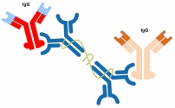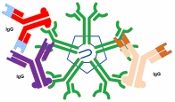Rheumatoid Arthritis Factors: IgM, IgG, IgA and IgE RF
Rheumatoid Arthritis Factors: IgM, IgG, IgA and IgE RF
Rheumatoid arthritis factor, which is more commonly called rheumatoid factor (RF), measures the amount of a person’s antibodies that bind to a conserved region of their IgG antibodies. Thus, RF antibodies bind to the IgG type of antibodies. As RF binds to IgG molecules, it can form very small clumps. RF comes in two main flavors: IgM RF antibody and IgA RF antibody and a less discussed flavor of IgE RF. (1)
IgA are found mainly in the gut, lungs, female genital tract, mammary glands, and nose. All IgA have 2 subunits --shown in dark blue--joined at the middle. Each of these subunits has 1 arm with 2 "baseball mitts" . The IgA RF have "baseball mitts" that catch IgG. Two of the four "baseball mitts" of IgA RF have caught IgG molecules by the foot, shown in red/blue and tan/rust (Figure 1 below).

Each healthy person has 5 basic types of antibodies: IgM are large antibodies that are made very early against invaders. IgG antibodies are made 2-3 weeks after the infection and usually found in the blood. IgA is made in the gut, nose, lungs, mammary glands, and other openings with mucus. IgE are made to mostly airborne particles and to parasites; they can trigger allergies.
The functions of these rheumatoid factor (RF) antibodies are to amplify an immune response to a disease-causing bacteria, virus, parasite, or mold so your body can more quickly clear the infection.
All IgM antibodies have five subunits. Each subunit has 2 arms that can bind to their target—in this case normal IgG.
Here's an cartoon of a IgM RF: note it has 5 units with "2 baseball mitts" attached to an arm--shown in green. In this case, three of these ten mitts have caught IgG--shown in red/blue; purple; and tan/rust.
The IgM RF antibody in Fig. 2 is shown as a flat structure. IgM rheumatoid arthritis factor is more like a central ring linking 5 forearms with 10 hands grabbing for any IgG, like 10 "baseball mitts".

IgE RF has been associated with lung nodules and other sites of disease activity besides joints.(1)
Measurement of Rheumatoid arthritis factor (rheumatoid factor, RF)
The quantity of RF is measured as a titer and expressed as the denominator of the titer. For example, a person’s serum is diluted in half for 10 times (1/2, 1/4, 1/8, 1/16, 1/32, 1/64, 1/128, 1/256; 1/512, 1/1032). The smallest quantity of serum (highest dilution) that still binds to normal human IgG molecules is your titer. Most laboratories express it as the denominator so a patient with a positive titer of 1/256 is stated to have 256 IU of RF.
The levels of RF in most healthy people are 15 IU/mL or less.
What
does a high Rheumatoid factor mean?
Higher risk of joint damage.
Adults with seropositive RA (with significant rheumatoid factors) are more likely to get joint damage.
Likewise, some children diagnosed with juvenile idiopathic arthritis have high levels of rheumatoid factor, either IgM or IgA. The RF positive children had a higher risk for joint damage within 8 years than those children without RF.(2)
Can healthy people have positive rheumatoid arthritis factor titers?
Yes. Rheumatoid factor is present in about 5 of every hundred healthy people.
Is rheumatoid factor
found in people with
other autoimmune diseases?
Yes. About one in eight patients
with scleroderma (hardening of the skin) have positive RF tests.(3) It correlated with disease activity in at least one study. (4)
Some patients with Sjogren’s syndrome (dry mouth, eyes, etc), or with systemic lupus erythematosus also have positive RF titers.
Is rheumatoid arthritis factor found in people with other diseases?
Yes. Some patients with cancer, chronic infections, cirrhosis of the liver, inflammatory lung disease, or mixed connective tissue disease have positive titers of RF.
Selected references
1 Herrmann D, Jager L, Hein G, Henzgen M, Schlenvoigt G. IgE rheumatoid factor. Occurrence and diagnostic importance in comparison with IgM rheumatoid factor and circulating immune complexes. J. Investig. Allergol. Clin. Immunol. 1991;1(5):302-307.
2 Berntson L, Nordal E, Fasth A et al. Anti-type II collagen antibodies, anti-CCP, IgA RF and IgM RF are associated with joint damage, assessed eight years after onset of juvenile idiopathic arthritis (JIA). Pediatr Rheumatol Online J 2014;1222.
3 Ueda-Hayakawa I, Hasegawa M, Kumada S et al. Usefulness of anti-cyclic citrullinated peptide antibody and rheumatoid factor to detect rheumatoid arthritis in patients with systemic sclerosis. Rheumatology (Oxford). 2010;49(11):2135-2139.
4 Mimura Y, Ihn H, Jinnin M, Asano Y, Yamane K, Tamaki K. Rheumatoid factor isotypes in localized scleroderma. Clin. Exp. Dermatol. 2005;30(4):405-408.